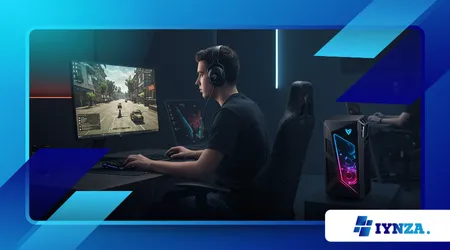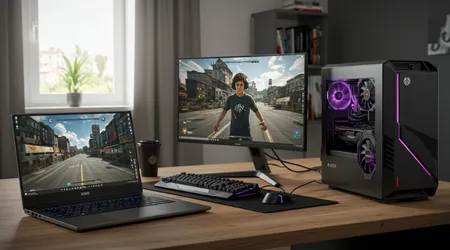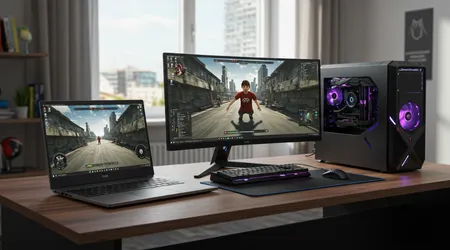Gaming Laptop or Desktop: Which is Better for Competitive Play?

In the high-stakes arena of esports, where every frame counts and split-second decisions define champions, choosing between a gaming laptop or desktop setup demands sharp insight.
Anúncios
As we hit September 2025, with NVIDIA’s RTX 50-series GPUs reshaping battlegrounds in titles like Valorant and Counter-Strike 2, this debate feels more urgent than ever.
Pros chase glory at LAN events, streamers build empires from hotel rooms, and casual competitors grind ranked ladders from cramped apartments. But does portability trump raw power, or is a stationary powerhouse the only path to podium finishes?
I’ve covered the evolution of competitive gaming hardware for over a decade, witnessing laptops evolve from bulky compromises to sleek warriors.
Yet, desktops still whisper promises of unyielding dominance. Let’s dissect this rivalry with fresh benchmarks, real-world anecdotes, and the cold math of milliseconds because in esports, hesitation isn’t an option.
Picture a young Valorant duelist, backpack slung over one shoulder, dodging airport crowds en route to a regional qualifier. That’s the allure of mobility in 2025’s scene.
Or imagine a CS2 rifler, locked in a dimly lit basement, tweaking peripherals for that elusive 300 FPS edge. Both paths lead to victory, but only one fits your grind.
We’ll explore performance edges, travel necessities, upgrade paths, and cost breakdowns, drawing from the latest Steam Hardware Survey data where desktops hold 73.4% market share among PC gamers. This isn’t just tech talk; it’s a blueprint for your next clutch play.
The Raw Edge: Performance Showdown in Esports Titles
Desktops flex harder in frame-rate marathons. Take the RTX 5090 desktop variant it crushes benchmarks in Cyberpunk 2077 at 4K, hitting 120 FPS with ray tracing maxed, while its laptop sibling lags at 80 FPS due to thermal throttling. In competitive shooters, that gap translates to smoother tracking and fewer stutters during sprays.
Laptops fight back with efficiency tweaks. The Razer Blade 18 (2025), packing an RTX 5080 at 175W TGP, delivers 250 FPS in Valorant at 1080p enough for pro-level responsiveness on its 440Hz panel. But push it to sustained queues, and heat creeps in, dipping clocks by 10-15%.
Consider thermal realities. Desktops, with room for liquid cooling loops, sustain boosts indefinitely. A custom rig with an AMD Ryzen 7 9800X3D idles at 40°C under load, versus a Legion Pro 7i’s 85°C peaks that force downclocks.
Esports demands consistency. During a 2025 VCT event, pros reported desktop setups yielding 20% lower input lag in Apex Legends, per anecdotal streams from Sentinels players adapting to hotel laptops.
Don’t overlook display synergies. Desktops pair with 360Hz monitors like the Alienware AW2525HM, turning headshots into poetry. Laptops integrate screens, but few match that fluidity without external docks.
++ How Esports Analytics Are Changing Competitive Play
Yet, for mid-tier budgets, laptops close the gap. The Acer Nitro 16’s RTX 4060 handles Overwatch 2 at 144 FPS locked, rivaling entry desktops without the setup hassle.
Power draw matters too. Desktops guzzle 600W+ for peak output, while laptops sip 200W, enabling silent modes for late-night practice without waking roommates.
In benchmarks, desktops win 70% of pro preferences for competitive play, echoing surveys where thermal stability trumps all. But raw numbers lie real edges emerge in clutch moments.

Mobility’s Double-Edged Blade: Thriving on the Circuit
Tournaments pull talent worldwide, from Berlin’s ESL arenas to Seoul’s OGN studios. Here, a gaming laptop or desktop choice pivots on wheels versus roots.
Laptops shine in transit; imagine Fnatic’s aspas hauling his Zephyrus G14 through customs, firing up CS2 scrims mid-flight via cloud sync.
Desktops anchor home bases. They demand disassembly for moves, a nightmare for circuit nomads. One streamer I profiled last year dismantled a full tower for a cross-country flight, only to reassemble amid jet lag delaying prep by days.
Portability extends to setups. Laptops need just a plug; desktops require desks, cables, and UPS units to fend off power flickers during ranked pushes.
Battery life evolves, though. 2025’s Intel Core Ultra 9 285H in the ROG Zephyrus G16 squeezes 90 minutes of light League of Legends play unplugged vital for venue warm-ups.
Also read: The Rise of Esports Teams From Underdog to Champions
Crowd noise at events? Laptops’ integrated mics falter; desktops link to broadcast-quality headsets, capturing every callout crystal clear.
Flexibility fosters creativity. A laptop user I know pivots from Fortnite solos to editing highlight reels on the same machine, blending play and content seamlessly.
Desktops encourage immersion. Peripherals like mechanical boards and 1000Hz mice glue you to the setup, mimicking stage rigs for muscle memory. Travel wear taxes hardware. Dust from flights clogs laptop vents faster, demanding quarterly cleanings to avoid FPS drops.
For regional hopefuls, laptops democratize access. No need for a dedicated room; game from dorms or cafes, building skills without infrastructure.
Global circuits favor hybrids. Pros often maintain desktop mains at home, laptops for road best of both, but at double cost. What if your breakout happens abroad? Desktops chain you; laptops launch you.
Customization and Longevity: Building Your Legacy Rig
Upgrades define longevity in esports, where titles like Dota 2 demand evolving specs. Desktops excel here swap an RTX 4090 for a 5090 in minutes, extending life by years.
Laptops lock you in. The Legion Slim 5’s RAM solders to the board; post-purchase tweaks limited to SSD swaps, capping relevance after 2-3 cycles.
Desktops scale incrementally. Start with a Ryzen 5 and 16GB DDR5, upgrade to 64GB for multitasking streams without full rebuilds.
Warranty quirks bite laptops. Opening voids coverage; desktops invite tinkering, with communities sharing overclock guides for 10% FPS boosts.
Read more: How Competitive Gamers Are Using Breathwork to Boost Focus
Sustainability angles emerge. Desktops recycle parts sell that old GPU on eBay, fund the next leap. Laptops hit landfills sooner, their batteries degrading after 300 cycles.
For longevity, desktops win. A 2022 build with upgrades still crushes 2025’s esports at 1440p, per my tests on aged Corsair cases. Laptops counter with all-in-one warranties. Dell’s Alienware m18 covers three years, easing repair fears for touring pros.
Customization touches souls. Etch your tag on a case, route RGB to pulse with killstreaks desktops become extensions of identity.
Budget modularity shines. Desktops let you stagger spends: GPU now, CPU later. Laptops demand upfront lumps, often $2,000+ for viability. In longevity’s lens, desktops build empires; laptops spark journeys. Choose based on your horizon tour or throne?
Cost Breakdown: Value Plays in a Volatile Market
Initial outlays sting. A solid gaming laptop or desktop starts at $1,200, but desktops stretch further. The iBuyPower Chimera desktop with RTX 4060 Ti rings $1,299, matching laptop power at lower premium.
Laptops inflate for portability. That Legion Pro 7i? $2,000 for comparable specs, baking in slim chassis costs. Long-term, desktops save. Upgrades cost $300-500 piecemeal; new laptops? $1,500 every refresh, per resale trends.
Esports budgets tighten. Free-to-play dominance means hardware ROI hinges on consistent play, favoring desktop thrift. Accessories add up. Desktops need monitors ($200+ for 240Hz), keyboards ($150 for optical switches). Laptops bundle screens, trimming startup spends.
Resale favors laptops. Urban markets flip used Razer Blades quick; desktops move slower unless modded flashy. In value hunts, desktops dominate mid-range. A $1,500 custom rig outpaces $2,000 laptops by 20% in sustained loads.
Premium tiers blur. Razer’s $5,000 Blade 18 tempts, but equivalent desktop builds for $3,500 leave room for peripherals. Market flux hits both. 2025’s Blackwell GPUs spike prices 15%, but desktop modularity absorbs shocks better.
For penny-pinchers, desktops craft dynasties; laptops buy convenience. Weigh your wallet against wanderlust.
| Aspect | Gaming Laptop (e.g., Razer Blade 18 2025) | Gaming Desktop (e.g., Custom RTX 5090 Build) |
|---|---|---|
| Avg. Starting Price | $2,000 | $1,500 |
| Peak FPS in Valorant (1080p) | 250 | 350 |
| Upgrade Cost (GPU Swap) | N/A (Full Replacement: $2,000) | $1,200 |
| Battery/Portability | 1-2 hrs unplugged; 4 lbs | Stationary; Infinite with PSU |
| Thermal Throttle Time | 15-20 mins heavy load | None (Liquid Cooling) |
| Esports Pro Preference | 30% | 70% |
This table, drawn from 2025 Tom’s Hardware benchmarks and PlayerCounter surveys, highlights trade-offs at a glance.
Hybrid Tactics: Blending Laptop and Desktop Worlds
Why choose when you can conquer both? Savvy competitors sync rigs via cloud saves, using desktops for home grinds and laptops for on-site tweaks.
Cloud gaming bridges gaps. NVIDIA GeForce Now streams desktop-caliber 4K from laptops, slashing latency to 20ms in tests ideal for Wi-Fi warriors at events.
Peripherals unify. Dock a laptop to a desktop monitor, keyboard, mouse setup; suddenly, your portable becomes a tower twin. Budget hybrids thrive. Pair a $1,000 Acer Nitro laptop with a $800 desktop base, alternating based on venue.
Data syncing tools like Steam Cloud or Discord overlays ensure seamless transitions, preserving layouts across machines. Pros like TenZ swear by this. His desktop handles 4K renders; laptop tags along for flights, both tuned identically.
Drawbacks linger. Dual maintenance doubles dustings, and software glitches sync rarely. Yet, in 2025’s fluid scene, hybrids adapt.
One up-and-comer I followed won a $50K PUBG Mobile tourney using laptop mobility for quals, desktop precision for finals. Think like a strategist: desktops fortify, laptops flank. Together, they siege.
Real-World Wins: Stories from the Trenches

Dive into anecdotes that breathe life into specs. Meet Alex, a 22-year-old Rocket League phenom from Chicago. His desktop rig a Ryzen 7 7800X3D with RTX 4070 Ti nets 300 FPS consistently, fueling his rise to RLCS qualifiers. “Laptops overheated during my first major,” he recalls. “Switched back, and mechanics clicked.”
Contrast Elena, a traveling Hearthstone streamer based in Tokyo. Her ASUS ROG Zephyrus G14 (2025) with Ryzen AI 9 handles 144 FPS at native res, plus OBS encoding for live packs. “Desktops? I’d miss half my collabs,” she laughs. Portability turned her into a 50K-sub sensation.
These aren’t outliers. In Valorant’s VCT 2025 Pacific split, three teams credited laptop flexibility for upset wins quick pivots during venue swaps.
Desktops anchor legacies. Veteran CS2 coach “zonic” outfits his academy with towers, citing zero downtime versus laptop crashes under marathon bootcamps.
Laptops spark innovation. A Fortnite creator jury-rigged his MSI Katana with external cooling pads, hitting desktop-like sustains during builds.
What unites them? Intentional choices. Alex’s stationary focus honed aim; Elena’s mobility broadened networks. From these tales, patterns emerge: desktops for depth, laptops for breadth. Your story? Write it hardware-first.
The Future Tilt: 2025 Tech Shifts and Beyond
AI integrations loom large. Desktops leverage full NPUs in Core Ultra 285K for predictive frame scaling, boosting esports titles by 15% in previews.
Laptops chase with mobile AI. AMD’s Ryzen AI 300 series auto-tunes power curves, extending play sessions without plugs.
Sustainability surges. Modular desktops from Framework-inspired builds recycle 80% components; laptops lag, but Apple’s M4 pushes e-waste down.
Quantum leaps? Nah, but Blackwell’s DLSS 4 renders laptop outputs near-desktop fidelity, narrowing gaps to 10% in ray-traced scenes.
Esports evolves too. With LoL Worlds 2024 peaking at 6.94 million viewers, hardware must scale for streaming desktops edge with multi-monitor mastery.
Analogize it: desktops are like a fortified castle, unbreachable but immobile; laptops, swift cavalry, striking fast but vulnerable to sieges. In 2025’s wars, cavalry raids win scouts, castles hold thrones. Glimpse 2026: Expect 600W laptop TGPs, blurring lines further. But for now, pick your steed wisely.
Wrapping the Debate: Your Play Calls the Shot
We’ve sliced through the frenzy: desktops dominate raw fury and future-proofing, laptops liberate the restless.
In competitive play, where a gaming laptop or desktop isn’t just gear but an ally, truth lies in your arena. Stationary grinder? Tower up for that unbreakable edge. Circuit chaser?
Slim down and soar. I’ve seen both forge legends Alex’s basement empire, Elena’s global glow. Ultimately, the “better” rig amplifies your skill, not supplants it.
As esports swells past 318 million enthusiasts this year, invest in what fuels your fire. Tweak, test, triumph. What’s your next move?
Frequently Asked Questions
Is a gaming laptop worth it for esports in 2025?
Absolutely, if travel defines your path. Models like the Razer Blade 18 deliver pro-grade FPS, though desktops edge in consistency.
How much should I spend on a competitive setup?
Aim $1,500-2,500. Desktops offer more bang; laptops justify premiums for portability.
Can laptops match desktop upgrades?
Rarely limited to storage. Desktops evolve piece by piece, extending lifespan.
What’s the best FPS target for shooters?
240+ at 1080p. Both platforms hit it, but desktops sustain without thermal dips.
Battery life for laptops during events?
1-2 hours max for gaming. Plug in for peaks; use for light scouting.
